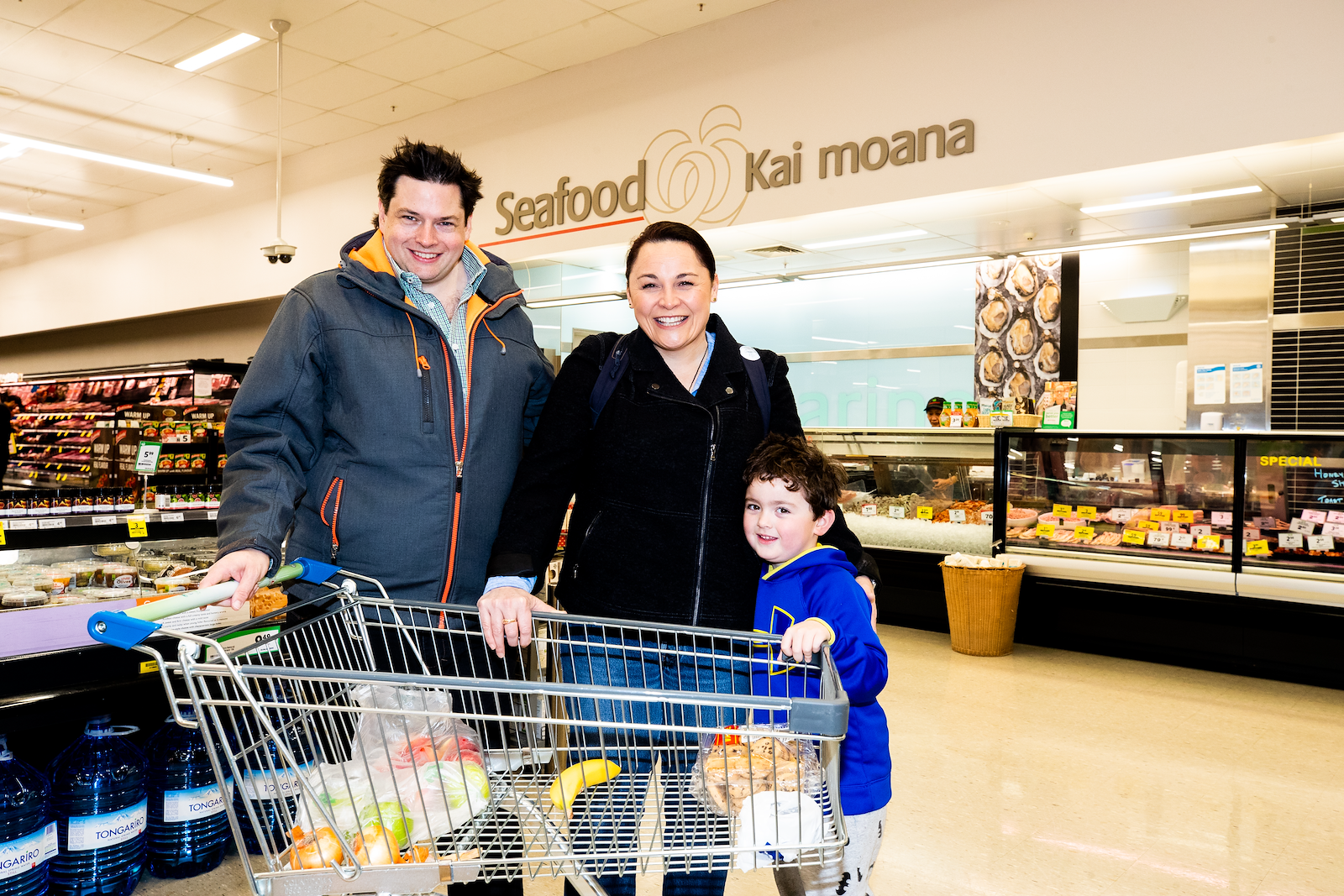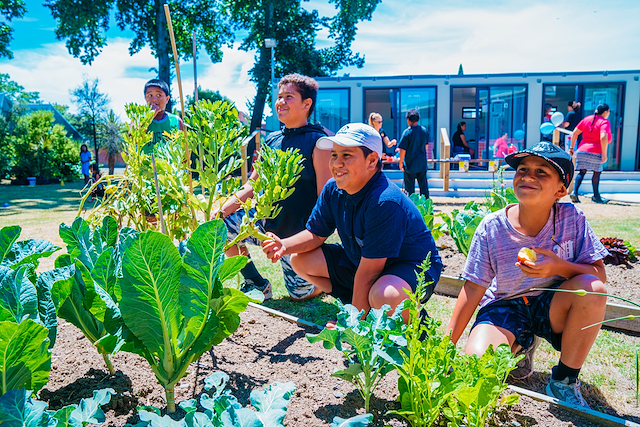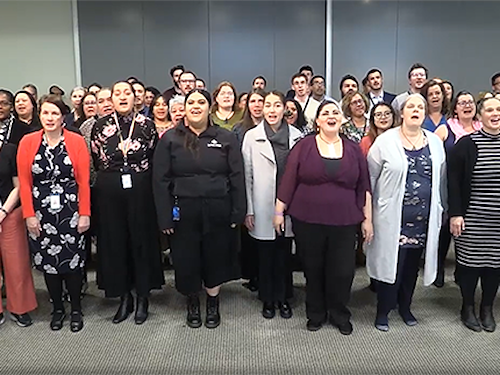The Maihi Karauna is the Crown’s Strategy for Māori Language Revitalisation 2019 – 2023.
Last updated: Tuesday, 18 July 2023 | Rātū, 18 Hōngongoi, 2023
What's on this page?

What is the Maihi Karauna?
The Maihi Karauna sets out a vision for te reo Māori in the future. It outlines what the Crown will do to support a strong, healthy, thriving Māori language in New Zealand; Kia māhorahora te reo – everywhere, everyway, for everyone, every day.
Download the Maihi Karauna strategy in te reo Māori [PDF, 1.8MB] or English [PDF, 1.8MB].
Public consultation
Public consultation on the Maihi Karauna strategy closed on 30 September 2018. We received more than 2000 responses in English and Māori.
The nature of public feedback showed a strong passion and interest in te reo Māori and its place in the national identity of Aotearoa.
Feedback informed the finalisation of the strategy. Helpful suggestions were made to ensure implementation of the Maihi Karauna would achieve its vision, goals, and priorities.
You can read the full report on public feedback here [PDF. 2.8MB].
What are the goals of the Maihi Karauna?
The Maihi Karauna sets out three audacious goals to achieve by 2040;
- 85% of New Zealanders (or more) will value te reo Māori as a key part of national identity.
- One million New Zealanders (or more) will have the ability and confidence to talk about at least basic things in te reo Māori.
- 150,000 Māori aged 15 and over will use te reo Māori as much as English.
Who is the Maihi Karauna for, and why?
The Maihi Karauna is for all New Zealanders. Everyone can support the revitalisation of te reo Māori, whether you speak the language or not.
The strategy addresses the revitalisation of the language by including a broad range of New Zealanders while also acknowledging the need to protect the integrity of te reo and recognise its kaitiakitanga (guardianship) by iwi and Māori.
There are also three groups in particular the strategy focuses on:
Tamariki and rangatahi

All young people in New Zealand up to 24 years old. Young people are the future of te reo Māori.
Tāngata matatau ki te reo (fluent speakers)

These are the expert speakers of te reo Māori. They are the Māori language teachers to the next generation, in homes and in the education system. They are also the upholders of the quality and integrity of mātauranga Māori (Māori knowledge).
Public servants

People who work in the public sector, are often on the front line, face to face, delivering services. In order for the Crown to recognise the value of the Māori language, to actively protect it and reflect the people of New Zealand, the Crown and its staff need to ‘speak’ the language itself.
Where does the Crown want to get to?
The Crown has three key outcomes:
- Aotearoatanga - te reo Māori is valued by Aotearoa whānui as a central part of national identity.
- Mātauranga - Aotearoa whānui has increased levels of knowledge, skill and proficiency in te reo Māori.
- Hononga - Aotearoa whānui is able to engage with te reo Māori.
How will the Maihi Karauna be implemented?
On December the 11th 2018 the Māori Crown Relations – Te Arawhiti (MCR) Committee decided that the implementation of the Maihi Karauna be staged over a number of years. The phases for implementation are:
- Establishment phase (11 December 2018 to 30 June 2019)
- First wave of initiatives (1 July 2019 to 30 June 2020)
- Scale-up phase (1 July 2020 to 30 June 2021)
- Consolidation phase (1 July 2021 to 30 June 2022)
- Review phase (1 July 2022 to 30 June 2023)
The establishment phase is now complete with the publication of an implementation plan developed by Te Puni Kōkiri and Te Taura Whiri i te Reo Māori.
This plan describes implementation activities for the Maihi Karauna over the 2019/2020 financial year.
The initiatives outlined within this plan have been categorised by the outcomes and priorities that they most directly contribute to, and by the following categories:
- Existing work
- Modified work
- New initiatives
These three categories have been used so that a shift from a business-as-usual approach can be captured in the first five years of the strategy.
You can learn more about these activities and how they will support the Maihi Karauna through reading the full implementation plan in te reo Māori [PDF, 1MB] or English [PDF, 1MB].
How will we track the Maihi Karauna progress?
Te Puni Kōkiri, supported by Te Taura Whiri i Te Reo Māori, developed a monitoring and evaluation framework for the Maihi Karauna.
The monitoring component of this framework will allow Government [JM2] to track strategy implementation and progress towards achieving the goals, outcomes and priorities of the Maihi Karauna.
The evaluation component will focus on if and how the Maihi Karauna is effective in achieving its objectives, and where improvements can be made.
- Download and read the full framework here [PDF, 1.5MB].
- Read the framework on a page here [PDF, 66KB].
What is the current state of te reo Māori?
Te Puni Kōkiri released a baseline indicators report in September 2019 that brought together all current information to highlight progress against the outcomes and audacious goals of the Maihi Karauna.
- Download and read the full report here [PDF, 1.6MB].
Te Puni Kōkiri has developed the first update to the baseline indicators report, using data up to December 2021.
- Download and read the updated indicators report here [PDF 1.5MB].
- Download and read the updated indicators report in te reo Māori [PDF 1MB]
Data was unavailable to update several indicators, including audacious goal 1 (Aotearoatanga/nationhood), due to disruption to the 2020 General Social Survey (GSS) by the COVID-19 pandemic and associated lockdown measures. New GSS data will be released in mid-2022 and will be included in the next update to the baseline indicators report for the Maihi Karauna.
Understanding the progress being made is critical in achieving the goals, outcomes and priorities outlined in the Maihi Karauna strategy. It also helps the government to effectively plan how best to continue its revitalisation and the achievement of the overall goal of Te Whare o te reo Mauriora ‘Kia Mauriora te reo.
Maihi Karauna and Maihi Māori

Te Whare o te Reo Mauriora
Te Ture mō te Reo Māori 2016 (the Māori language Act 2016) created a new way of approaching language revitalisation.
The Act established a partnership between the Crown and iwi and Māori, who are represented by Te Mātāwai.
- Te Mātāwai focuses on homes, communities and the nurturing of Māori children as first language speakers of te reo Māori.
- The Crown focuses on creating a New Zealand society where te reo Māori is valued, learned and used by developing policies and services that support language revitalisation.
This is the first time the Crown and Māori, represented by Te Mātāwai, have entered into an active, planned partnership for revitalisation. Together they are working towards a shared vision, kia mauriora te reo.
When that vision is achieved it is expected that;
- Kia rere: Māori language is shared and used in daily life.
- Kia tika: Māori language is fit for purpose.
- Kia Māori: Māori language is a first language and shared.
Watch this video that explains Te Whare o te Reo Mauriora and the relationship between the Maihi Māori and the Maihi Karauna.
Who has developed the Maihi Karauna?
The Maihi Karauna has been developed by Te Puni Kōkiri, Te Taura Whiri i te Reo Māori, Te Māngai Pāhō, the Māori Television Service, Ministry of Education, Department of Internal Affairs and Manatū Taonga, the Ministry for Culture and Heritage.
Related News and Stories
Read our latest news and stories for this kaupapa.

Kia whakanuia ki te Mahuru Māori 2023
Reo Māori stories, team waiata and inter-office kapa haka performances helped bring Mahuru Māori to life at Te Puni Kōkiri.

Join Te Wiki o te Reo Māori movement
Te Wiki o te Reo Māori started on 14 September 1972, in recognition of the 30,000-signature strong petition to parliament for te reo Māori to be taught in schools.

It's International Day of the World's Indigenous Peoples
To all indigenous peoples of the world, kia pai to rā! International Day of the World’s Indigenous Peoples is celebrated and acknowledged every year on 9 August.

Recognising Matariki Stars of Aotearoa
Ngā Tohu Matariki o te Tau provides the opportunity to acknowledge and celebrate those who have made considerable contributions to Aotearoa across a range of diverse backgrounds and sectors, locally, nationally and globally.

Tō Uru Raumati, Have Yours?
More than 20 of our top performers have come together in empty venues across Aotearoa to deliver one message - Tō Uru Raumati (Your Summer Pass), Have Yours?

Growing confident, connected young leaders
Since completing a Māori leadership programme, a remarkable group of rangatahi have become community volunteers, part time employees and university enrolled students. What inspired this standard of result? Whakapapa, whenua and community.